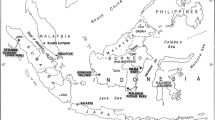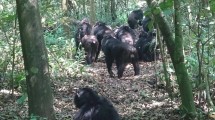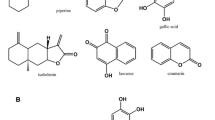Abstract
Detoxification as the adaptive function of geophagy is demonstrated from field and historical data associating clay consumption with the domestication of potentially toxic potatoes. In vitro analyses showed that the glycoalkaloid, tomatine, was effectively adsorbed by four classes of edible clays over a range of simulated gastrointestinal conditions. These results, in conjunction with reports of geophagy by nonhuman primates, suggest geophagy as a solution to the impasse chemical deterrents pose to the process of domestication and to chemical constraints on plant exploitation by non-fireusing hominids. The inorganic component of the chemical environment deserves increased attention from chemical ecologists.
Similar content being viewed by others
References
Anell, B., andLagercrantz, S. 1958. Geophagical customs.Stud. Ethnogr. Ups. 17:1–84.
Bailey, F.L. 1940. Navaho foods and cooking methods.Am. Anthropol. 42:270–290.
Barr, M., andArnista, E.S. 1957. Adsorption studies on clays 1: The adsorption of two alkaloids by attapulgite, halloysite and kaolin.J. Am. Pharm. Assoc. 46:486–489.
Bernstein, I.L. 1978. Learned taste aversions in children receiving chemotherapy.Science 200:1302–1303.
Browne, J.E., Feldkamp, J.R., White, J.L., andHem, S.L. 1980. Acid-base equilibria of tetracycline in sodium montmorillonite.J. Pharm. Sci. 69:811–815.
Burchfield, S.R., Elich, M.S., andWoods, S.C. 1977. Geophagia in response to stress and arthritis.Physiol. Behav. 19:265–267.
Clutton-Brock, T.H. (ed.) 1977. Primate Ecology: Studies of Feeding and Ranging Behavior in Lemurs, Monkeys, and Apes. Academic Press, London, 631 pp.
de Wet, J.M.J., andHarlan, J.R. 1975. Weeds and domesticates: Evolution in the man-made habitat.Econ. Bot. 36:225–241.
FAO. 1983. FAO Production Yearbook, Vol. 37. Food and Agriculture Organization of the United Nations, Rome. 320 pp.
Fitzpatrick, T.J., andOsman, S.F. 1974. A comprehensive method for determination of total potato glycoalkaloids.Am. Potato J. 51:318–323.
Freeland, W.J., andJanzen, D.H. 1970. Strategies in herbivory by mammals: The role of plant secondary compounds.Am. Nat. 108:269–289.
Garb, J.L., andStunkard, A.J. 1974. Taste aversions in man.Am. J. Psychiatry. 131:1204–1207.
Garcia, J., Hankins, W.G., andRusiniak, K.W. 1974. Behavioral regulation of the milieu interne in man and rat.Science 185:824–831.
Gregory, P. 1984. Glycoalkaloid composition of potatoes: Diversity and biological implications.Am. Potato J. 61:115–122.
Gregory, P., Sinden, S.L., Osman, S.F., Tingey, W.M., andChessin, D.A. 1981. Glycoalkaloids of wild, tuber-bearingSolanum species.J. Agric. Food Chem. 29:1212–1215.
Harborne, J.B. 1982.Introduction to Ecological Biochemistry, 2nd ed., Academic Press, London, 278 pp.
Hendricks, S.B. 1941. Base exchange of the clay mineral montmorillonite for organic cations and its dependence upon adsorption due to van der Waals forces.J. Phys. Chem. 45:65–81.
Hladik, C.M. 1977. Chimpanzees of Gabon and Gombe: Some comparative data on the diet, pp. 481–501,in T.H. Clutton-Brock (ed.). Primate Ecology. Academic Press, London.
Hladik, C.M. 1978. Adaptive strategies of primates in relation to leaf-eating, pp. 373–395,in C.G. Montgomery (ed.). The Ecology of Arboreal Folivores. Smithsonian Institution Press, Washington, D.C.
Hladik, C.M., andGueguen, L. 1974. Geophagie et nutrition minerale chez les primates sauvages.C.R. Acad. Sci., Paris 279:1393–1396.
Hunter, J.M., 1973. Geophagy in Africa and in the United States: A culture-nutrition hypothesis.Geogr. Rev. 63:170–195.
Jadhav, S.J., Sharma, R.P., andSalunkhe, D.K. 1981. Naturally occurring toxic alkaloids in foods.C.R.C. Crit. Rev. Toxicol. 9:21–104.
Johns, T.A. 1985. Chemical Ecology of the Aymara of Western Bolivia: Selection for Glycoalkaloids in theSolanum X ajanhuiri Domestication Complex. PhD dissertation. University of Michigan, Ann Arbor, 312 pp.
Laufer, B. 1930. Geophagy.Field Mus. Nat. Hist., Anthropol. Ser. 18:99–198.
Lentner, C. (ed.) 1981. Geigy Scientific Tables. Vol. 1. Medical Education Division Ciba-Geigy Corporation, West Caldwell, New Jersey, 97 pp.
Leopold, A.C., andArdrey, R. 1972. Toxic substances in plants and the food habits of early man.Science 176:512–514.
Marlow, R.W., andTollestrup, K. 1982. Mining and exploitation of natural mineral deposits by the desert tortoise,Gopherus agassizii.Anim. Behav. 30:475–478.
Martin, M.M., andMartin, J.S. 1978. Cellulose digestion in the midgut of the fungus-growing termiteMacrotermes natalensis: The role of acquired digestive enzymes.Science 199:1453–1455.
McGinty, J.W., andHill, J.A. 1975. Influence of monovalent and divalent electrolytes on sorption of neomycin sulfate to attapulgate and montmorillonite clays.J. Pharm. Sci. 64:1566–1568.
McKey, D.B., Cartlan, J.S., Waterman, P.G., andChoo, G.M. 1981. Food selection by black colobus monkeys (Colobus satanas) in relation to plant chemistry.Biol. J. Linn. Soc. 16:115–146.
Meshali, M.M. 1982. Adsorption of phenazopyridine hydrochloride on pharmaceutical adjuvants.Pharmazie 37:718–720.
Mitchell, D., Wells, C., Hoch, N., Lind, K., Woods, S.C., andMitchell, L.K. 1976. Poison induced pica in rats.Physiol. Behav. 17:691–697.
Mitchell, D., Beatty, E.T., andCox, P.K. 1977a. Behavioral differences between two populations of wild rats: Implications for domestication research.Behav. Biol. 19:206–216.
Mitchell, D., Winter, W., andMorisaki, C.M. 1977b. Conditioned taste aversions accompanied by geophagia: Evidence for the occurrence of “psychological” factors in the etiology of pica.Psychosomat. Med. 39:402–412.
Osman, S.F., Herb, S.F., Fitzpatrick, T.J., andSchmiediche, P. 1978. Glycoalkaloid composition of wild and cultivated tuber-bearingSolarnum species of potential value in potato breeding programs.J. Agric. Food Chem. 26:1246–1248.
Pennington, C.W. 1963. The Tarahumar of Mexico: Their Environment and Material Culture. University of Utah Press, Salt Lake City, 267 pp.
Ridout, C.W. 1967. The adsorption of atropine from aqueous solution by kaolin.Pharm. Acta Helv. 13:42–49.
Riley, A.L., andBaril, L.L. 1976. Conditioned taste aversions: A bibliography.Anim. Learn. Behav. 4:1s-13s.
Rindos, D. 1980. Symbiosis, instability, and the origins and spread of agriculture: A new model.Curr. Anthropol. 21:751–772.
Rowe, J.H. 1946. Inca culture at the time of the Spanish conquest, pp. 183–330,in J.H. Steward (ed.). Handbook of South American Indians, Vol. 2. Bureau of American Ethnology, Bulletin 143, Smithsonian Institution, Washington, D.C.
Shachak, E.A., Chapman, Y., andSteinberger, Y. 1976. Feeding, energy flow and soil turnover in the desert isopod,Hemilepistus reaumuri.Oecologia 24:57–69.
Smith, M. 1979. Behavior of the koala,Phascolarctos cinereus Goldfuss, in captivity I. Nonsocial behavior.Aust. Wildl. Res. 6:117–129.
Solien, N.L. 1954. A cultural explanation of geophagy.Fla. Anthropol. 7:1–9.
Stahl, A.B., 1984. Hominid dietary selection before fire.Curr. Anthropol. 25:151–168.
Theng, B.K.C. 1974. The Chemistry of Clay-Organic Reactions. John Wiley & Sons, New York. 343 pp.
Tschopik, H. 1946. The Aymara, pp. 501–573,in J.H. Steward (ed.). Handbook of South American Indians, Vol. 2. Bureau of American Ethnology, Bulletin 143, Smithsonian Institution, Washington, D.C.
Uehara, S. 1982. Seasonal changes in the techniques employed by wild chimpanzees in the Mahale Mountains, Tanzania, to feed on termites (Pseudacanthotermes spiniger).Folia Pritnatol. 37:44–76.
Vermeer, D.E., andFerrell, R.G. 1985. Nigerian geophagical clay: A traditional antidiarrheal pharmaceutical.Science 227:634–636.
Wai, K.-N., andBanker, G.S. 1966. Some physiochemical properties of the montmorillonites.J. Pharm. Sci. 55:1215–1220.
Weiss, P. 1953. Los comedores peruanos de tierras.Peru Indigena 5:12–21.
White, J.L., andHem, S.L. 1983. Pharmaceutical aspects of clay-organic interactions.Ind. Eng. Chem. Prod. Res. Dev. 22:665–671.
Whiting, A.F. 1939. Ethnobotany of the Hopi.Mus. North. Ariz. Bull. 15:1–120.
Windholz, M. (ed.). 1976. The Merck Index. Merck & Co., Rahway, New Jersey, 1313 pp.
Wrangham, R. 1977. Feeding behavior of chimpanzees in Gombe National Park, pp. 504–538,in T.H. Clutton-Brock (ed.). Primate Ecology. Academic Press. London.
Author information
Authors and Affiliations
Rights and permissions
About this article
Cite this article
Johns, T. Detoxification function of geophagy and domestication of the potato. J Chem Ecol 12, 635–646 (1986). https://doi.org/10.1007/BF01012098
Received:
Accepted:
Issue Date:
DOI: https://doi.org/10.1007/BF01012098




